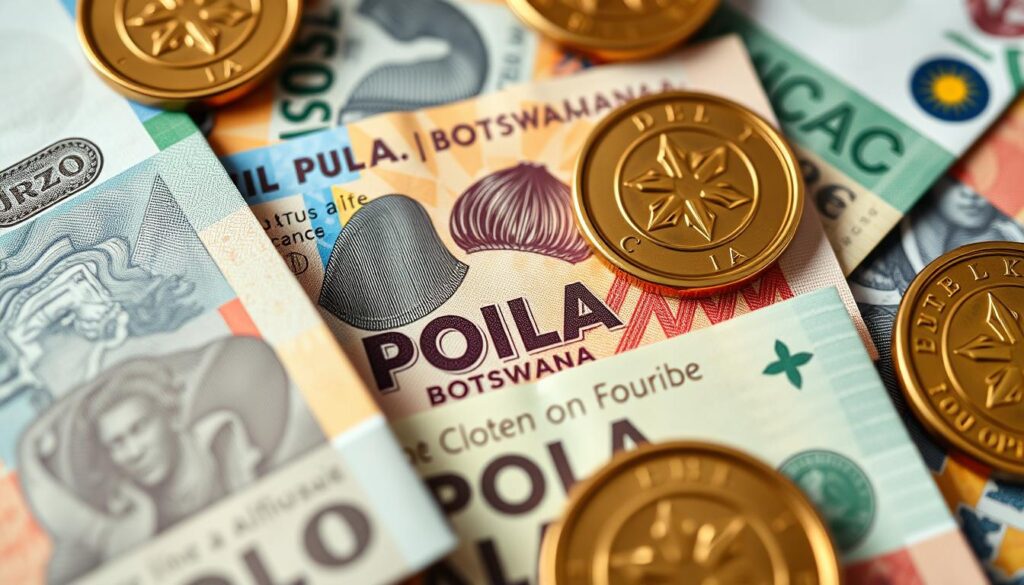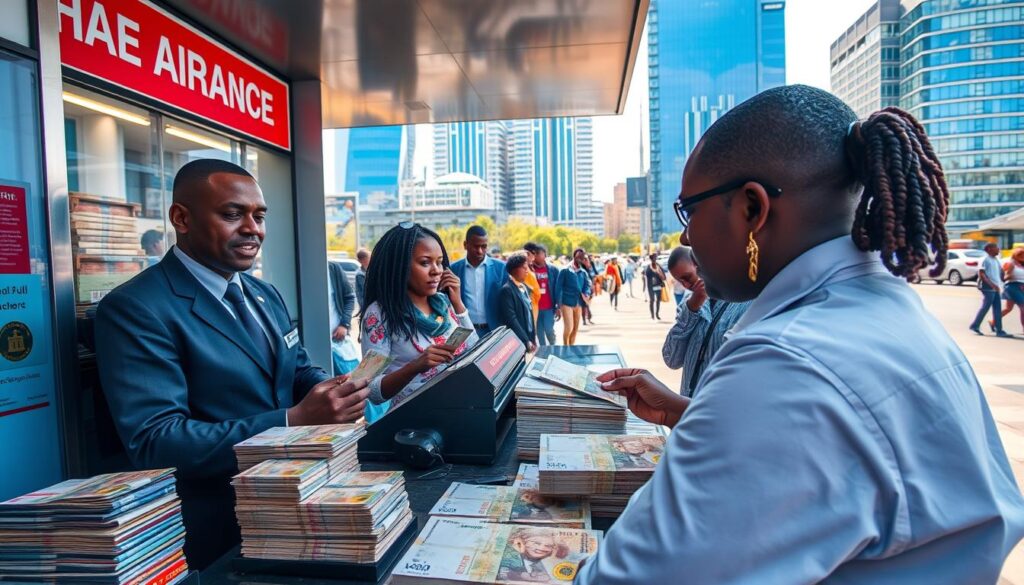
In the heart of Southern Africa lies Botswana, a landlocked country. It adopted its own official currency, the Botswana Pula, in 1976.
The Botswana Pula replaced the South African rand, marking a significant step in the country’s economic history. The Pula is subdivided into 100 units called thebe and is symbolized by the “P” sign.
The introduction of the Botswana Pula not only reflected the country’s move towards economic independence. It also symbolized its rich cultural heritage.
Key Takeaways
- The Botswana Pula is the official currency of Botswana.
- It was introduced in 1976, replacing the South African rand.
- The Pula is subdivided into 100 thebe.
- The currency is symbolized by the “P” sign.
- The adoption of the Pula marked a significant step in Botswana’s economic history.
The Botswana Pula: An Overview
The Botswana Pula is more than just the official currency of Botswana. It’s a symbol of the nation’s cultural heritage. The word “Pula” comes from the Setswana language, which is deeply rooted in the country’s culture.
Definition and Meaning of “Pula”
“Pula” means “rain” in Setswana. Rain is very precious in Botswana, where much of the land is desert. It’s seen as a blessing, bringing good fortune and prosperity.
Official Status and Recognition
The Pula is not just a currency; it’s a symbol of national identity. It was introduced to give Botswana a unique economic identity, separate from its colonial past. The Pula is used in all financial transactions in Botswana, making it key to the country’s economy.
The Pula’s cultural significance is highlighted by its role as the national motto. It represents the values and aspirations of the Botswana people. The currency’s design and imagery also show the country’s rich culture and natural beauty.
What Currency Does Botswana Use: Understanding the Pula
The Botswana Pula is the official currency of Botswana. Knowing about it is key for handling money in the country.
The Pula means “rain” in Setswana. It’s more than money; it shows Botswana’s economic and cultural spirit.
Currency Code and International Designation
The Botswana Pula has the ISO 4217 code “BWP.” This code is important for international trade and travel. It helps everyone understand the Pula worldwide.
With the BWP code, people and businesses can deal with the Pula easily. This is useful for exchange rates and financial reports.
The Pula Symbol and Its Representation
The Pula is marked by the letter “P.” This symbol is clear on money, making it easy to spot.
The Pula symbol is the same everywhere. This makes money dealings clear and simple.
Knowing the currency code and symbol is important. It helps locals and visitors in Botswana. It makes money dealings smooth and shows the Pula’s importance.
Historical Development of Botswana’s Currency
Exploring Botswana’s currency history sheds light on its economic journey. It shows how the country moved towards financial freedom. The story of Botswana’s currency spans decades, from before independence to the Pula’s introduction and growth.
Pre-Independence Currency Usage
Before gaining freedom in 1966, Botswana used the South African Rand. This was a result of colonial ties with South Africa. The Rand remained the currency until the Pula was introduced.
Introduction of the Pula in 1976
The Pula was launched on August 23, 1976. It was a key moment in Botswana’s economic history. The Pula allowed Botswana to control its money better, showing its financial independence.
The Pula replaced the Rand at the same value. Within 100 days, the Rand was no longer accepted in Botswana. This move was vital for Botswana’s economic freedom.
Evolution of the Currency Over Decades
Over time, the Pula has seen changes like new exchange rates and banknotes. These updates reflect Botswana’s economic growth. The Pula’s evolution shows Botswana’s ability to handle economic ups and downs.
The Bank of Botswana has been key in managing the currency. It ensures the Pula’s stability and keeps trust in the financial system. The Pula’s value has been shaped by Botswana’s diamond industry, policies, and regional trends.
Denominations of the Botswana Pula
The Botswana currency has many denominations to meet different financial needs. The Bank of Botswana issues the currency in various forms.
Banknotes in Circulation
The Bank of Botswana first introduced notes in 1, 2, 5, and 10 Pula. Later, a 20 Pula note was added on February 16, 1978. The banknotes have seen changes in design and security over time.
Available denominations of banknotes include a variety of Pula notes. These are widely accepted across the country.
Coins and Their Specifications
Coins were introduced in 1, 5, 10, 25, and 50 Thebe denominations. These coins are used for smaller transactions and have different designs.
The specifications of the coins have changed over the years. This includes improvements in material and design for better durability and security.
- 1 Thebe coin
- 5 Thebe coin
- 10 Thebe coin
- 25 Thebe coin
- 50 Thebe coin
The various denominations of the Botswana Pula, including banknotes and coins, are key to the country’s economy.
Design Features and Security Elements
The Botswana Pula’s design shows the country’s rich culture and economic growth. It’s more than just money; it’s a symbol of the nation’s identity.
Imagery and Symbolism on Botswana Currency
The Botswana Pula banknotes showcase the country’s culture and economy. They feature important national landmarks and symbols of wealth.
- The Parliament building is on some notes, showing the country’s stable government.
- Diamond mining equipment is on others, highlighting the diamond industry’s role in the economy.
These images make the currency beautiful. They also represent Botswana’s achievements and values.
Anti-Counterfeiting Measures
The Botswana Pula has advanced security features to fight counterfeiting. These include:
- Watermarks: Visible when light is shone through, watermarks are a key feature.
- Holograms: Some notes have holograms that shine and look three-dimensional.
- Microprinting: Tiny text that’s hard to copy is used throughout the notes.
These security measures keep the currency safe and build trust in the financial system.
The Bank of Botswana and Currency Management
The Bank of Botswana manages the country’s currency well. It acts as the central bank, overseeing the economy and keeping the financial system stable.
![]()
Role of the Central Bank
The Bank of Botswana is key to the economy. It manages money, watches over banks, and keeps the financial system stable. Its main goal is to keep prices stable, which helps the economy grow.
The central bank does many things:
- It makes and carries out money policies.
- It checks and supervises banks and other financial groups.
- It handles the country’s foreign money reserves.
- It keeps the financial system stable.
Currency Issuance and Regulation
The Bank of Botswana issues the country’s currency. It makes sure the money is distributed well and is of good quality. It also watches over money transactions to stop fake money and other bad activities.
Important parts of currency issuance and regulation are:
- It issues new money as the economy needs it.
- It takes out old or damaged money from use.
- It adds security features to stop fake money.
- It checks money transactions to find and stop bad activities.
The Bank of Botswana’s work with currency is vital for the country’s financial health. By managing the currency well, it helps the economy stay stable and grow.
Exchange Rates and Value of the Botswana Pula
The exchange rate of the Botswana Pula shows how well the country’s economy is doing. The Pula’s worth is linked to Botswana’s economic health, mainly because of the diamond industry.
Current Exchange Rates Against Major Currencies
The current exchange rates of the Botswana Pula against major currencies like the US Dollar, Euro, and British Pound are set by the foreign exchange market. Here are the latest rates:
| Currency | Exchange Rate (1 Pula =) |
|---|---|
| US Dollar | 0.092 USD |
| Euro | 0.078 EUR |
| British Pound | 0.067 GBP |
These rates can change based on market conditions. The Bank of Botswana helps manage the Pula’s value through its monetary policies.
Historical Value Fluctuations
The Botswana Pula’s value has changed over time due to different economic factors. The Pula was introduced in 1976, marking a big change in the country’s currency management. The Pula’s value has been influenced by global commodity prices, mainly diamonds.
“The value of the Pula is closely linked to the diamond industry, which is a significant contributor to Botswana’s economy.” – Bank of Botswana Report
Factors Affecting the Pula’s Value
Several things affect the Botswana Pula’s value, including:
- Commodity prices, mainly diamonds
- Economic performance of trading partners
- Monetary policies set by the Bank of Botswana
- Global economic trends
The supply and demand in the foreign exchange market also play a big role in setting the Pula’s exchange rate. Because Botswana’s economy relies heavily on diamond exports, changes in diamond prices can greatly affect the Pula’s value.
Botswana’s Currency Policy and Economic Impact
Understanding Botswana’s currency policy is key to knowing its economy. The country’s monetary authority uses many strategies to keep the economy stable. A big focus is on the exchange rate mechanism.
Crawling Peg Exchange Rate Mechanism
Botswana uses a crawling peg exchange rate mechanism. This lets the exchange rate adjust based on economic signs. It balances between fixed and floating rates, helping manage the Pula currency well.
This mechanism makes small changes to the exchange rate. It reflects things like inflation and foreign exchange reserves. This helps keep the country competitive and controls inflation.
Relationship Between Currency and Diamond Industry
The diamond industry greatly affects Botswana’s economy and currency. Diamonds are a big export, so price changes can affect the Pula’s value.
Diamond exports add a lot to Botswana’s foreign exchange reserves. This supports the Pula’s stability. The diamond industry is vital for Botswana’s economy.
Impact on Inflation and Economic Stability
The crawling peg mechanism affects inflation and stability. Adjusting the exchange rate can change import prices, which impacts inflation.
A stable currency is important for economic stability. It reduces uncertainty from currency changes. This stability is key for attracting foreign investment and growing the economy.
Using the Pula: Practical Information for Travelers
If you’re going to Botswana, knowing how to use the Pula can make your trip better. You can exchange your money for Pula at banks, exchange bureaus, and some hotels and airports.
Currency Exchange Tips for Visitors
When you exchange money, compare rates to find the best deal. Banks usually have good rates, but exchange bureaus might charge more. It’s smart to have some Pula when you arrive, as not all places take foreign money.
Using ATMs is a handy way to get Pula. Major credit and debit cards work at ATMs in cities and tourist spots.

Acceptance of Foreign Currencies in Botswana
The Pula is the local money, but some places might take US dollars or Euros. But, the exchange rates might not be good for you. It’s best to use Pula for buying things.
Banking and ATM Services for Tourists
Botswana has a good banking system, with ATMs in cities. You can withdraw Pula with your debit or credit card. Tell your bank you’re traveling to avoid any problems.
- Major banks like Barclays and Stanbic offer ATM services.
- Credit cards are accepted at most hotels, restaurants, and shops.
- Some banks also offer currency exchange services.
Digital Transactions and the Botswana Pula
Digital transactions are on the rise in Botswana. This is thanks to better electronic payment systems and mobile money services. It’s part of a global trend towards using digital currencies and payment methods.
Electronic Payment Systems in Botswana
Electronic payment systems are becoming popular in Botswana. They offer a safe and easy way to make payments. Users can pay and send money using their phones or computers, cutting down on cash use.
Key benefits of electronic payment systems include:
- Increased convenience
- Enhanced security
- Faster transaction processing
More people are using electronic payment systems. This is because technology is getting better and more people want digital payment options.
Mobile Money Services
Mobile money services are key in Botswana’s digital transactions. They let users store and send money with their phones. This helps people who can’t use traditional banks.
“The expansion of mobile money services has been instrumental in increasing financial inclusion in Botswana, enabling more people to participate in the formal economy.” – Financial Sector Report
Future of Digital Currency in Botswana
The future of digital currency in Botswana is bright. With more work on electronic payment systems and mobile money, we can expect new things in digital transactions.
The impact of digital currency on Botswana’s economy could be big:
- Increased financial inclusion
- Improved efficiency in transactions
- Enhanced economic stability
As Botswana keeps moving towards digital, the Botswana Pula will stay important. It will keep up with the financial changes and keep playing a key role in the economy.
Comparing the Pula to Other African Currencies
The Botswana Pula is seen as one of the most stable currencies in Africa. This is key when comparing it to other currencies on the continent. The stability comes from Botswana’s smart economic management and its wealth of diamonds.
Stability Compared to Neighboring Countries’ Currencies
The Botswana Pula is known for its relative stability. This is different from many neighboring countries. They face currency changes due to political issues and relying too much on one export.
Botswana’s diverse economy and careful spending help keep the Pula stable. For example, it keeps a steady value against the US dollar. This is unlike other regional currencies that have seen big changes.
Regional Economic Integration and Currency Implications
Efforts to unite African economies, like the African Continental Free Trade Area (AfCFTA), affect the Pula. More trade and cooperation can boost growth. But, they also make managing currencies harder.
As the region becomes more connected, there might be a push for a common currency. This could change how countries manage their money. The Pula’s stability could be impacted by how well other countries in the region do.
There’s also talk of linking the Pula to the South African Rand. This could affect the Pula’s value. Botswana will decide whether to stay independent or join with other currencies based on its economic goals and the risks involved.
Conclusion: The Significance of the Pula to Botswana’s Identity and Economy
The Pula is more than just money; it’s a symbol of Botswana’s identity and economic freedom. We’ve looked at the Pula’s role in the country’s economy and culture. This includes its history, design, and how it affects the economy.
The Pula shows Botswana’s rich culture and helps keep the economy stable. It’s used for trade and commerce at home and abroad. The Pula’s value is linked to Botswana’s diamond industry, which has boosted the economy.
Knowing about the Pula helps us understand Botswana’s economic strength. The Pula is key to Botswana’s growth and shows its economic independence. The Bank of Botswana works hard to keep the currency stable and trustworthy.
In short, the Pula is a big part of Botswana’s identity and economy. It reflects the nation’s history, culture, and economic freedom.
FAQ
What is the official currency of Botswana?
The official currency of Botswana is the Botswana Pula.
What does “Pula” mean in the context of Botswana’s currency?
“Pula” means a blessing in Botswana. It comes from the country’s scarce rain.
What is the currency code for the Botswana Pula?
The currency code for the Botswana Pula is BWP.
What is the symbol used to represent the Botswana Pula?
The Botswana Pula is symbolized by the “P” sign.
When was the Botswana Pula introduced as the national currency?
The Botswana Pula was introduced in 1976. It replaced the South African rand.
What are the subdivisions of the Botswana Pula?
The Botswana Pula is divided into 100 units called thebe.
What are the various denominations of banknotes and coins in circulation?
The Bank of Botswana issues different banknotes and coins. Their values vary.
How is the value of the Botswana Pula determined?
The Botswana Pula’s value is based on the country’s economy. The diamond industry plays a big role. The value is managed through a crawling peg exchange rate mechanism.
Can foreign currencies be used in Botswana?
Some businesses accept major foreign currencies. But, the Botswana Pula is preferred for transactions.
Are digital payment systems and mobile money services available in Botswana?
Yes, Botswana has seen growth in digital transactions. This includes electronic payment systems and mobile money services.
How does the Botswana Pula compare to other African currencies in terms of stability?
The Botswana Pula’s stability is compared to other African currencies. Its value is tied to the country’s economic performance.
What is the role of the Bank of Botswana in managing the country’s currency?
The Bank of Botswana issues and regulates the Botswana Pula. It also manages the country’s monetary policy.
What are the security features incorporated into the Botswana Pula?
The Botswana Pula has anti-counterfeiting measures. It also has symbolic imagery representing the nation’s heritage.
How can visitors exchange their currency for Botswana Pula?
Visitors can exchange their currency at banks or currency exchange offices. They can also use ATMs to withdraw Pula.
What is the impact of the diamond industry on the value of the Botswana Pula?
The diamond industry greatly affects the Botswana Pula’s value. It is a major contributor to the country’s economy.

Adam G
This post was created by Adam G, a seasoned financial writer with a passion for explaining currency exchange and market movements

1 thought on “What Currency is Used in Botswana? Discover the Botswana Pula and Its Value”